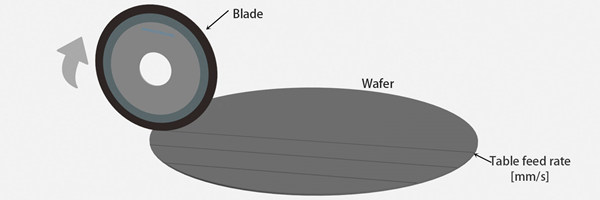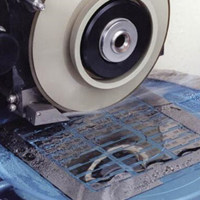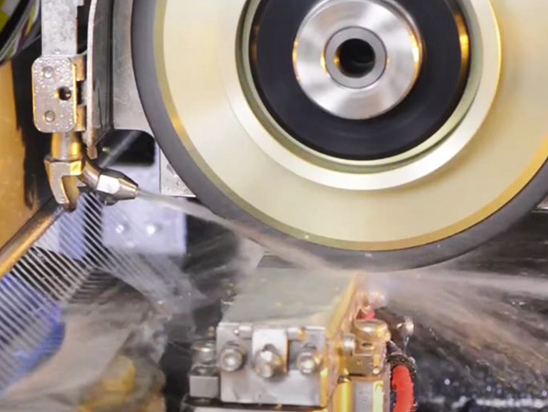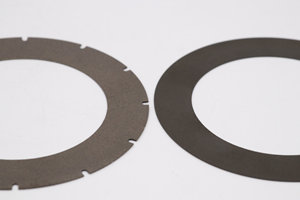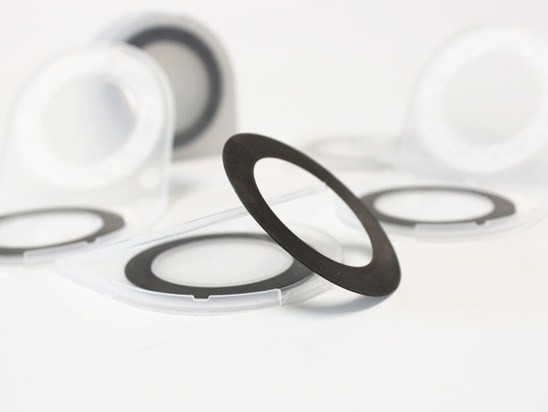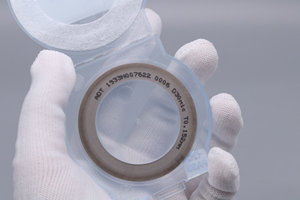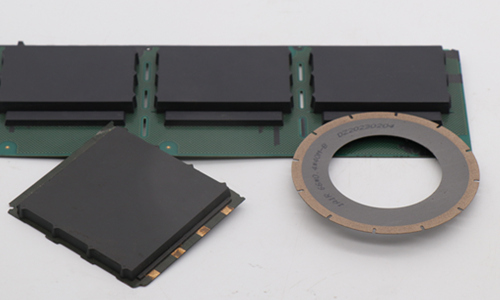How to select diamond dicing blade for precision dicing ?
What is diamond dicing blade?
The diamond dicing blade is mainly composed of electroformed nickel-based bond, resin and metal bond. When dicing, the spindle drives the blade to rotate to achieve high rigidity, thereby removing material to achieve cutting.
The diamond dicing blade is a tool used on a dicing machine. Diamond dicing blade can be used for various wafers, semiconductor packaging substrates, ceramics, glass and other hard and brittle materials. Its working principle: the diamond particles will be crushed by the cutting material under high-speed rotation, and the cutting water will drain away the debris at the same time, thereby achieving the purpose of cutting.
Diamond dicing blade: The blade edge is approximately rectangular, θ is close to 0°, the surface is rough, and there are raised hard particles and blade edges.
Use a diamond dicing blade to cut the wafer. The dicing knife (thickness 20~50um) is made of hard material with diamond particles added. The diamond dicing knife rotates tens of thousands of times per minute to cut the wafer, generating frictional heat. Therefore, it is necessary to continuously spray pure water under high pressure to remove the cut silicon fragments while cutting at the same time. Since pure water can cause electrostatic damage, carbon dioxide gas is usually mixed with pure water.
During the cutting process, the diamond particles are constantly worn away to expose new particles, keeping the blade sharp and able to clean out cutting debris normally. The chips generated during cutting will adhere to the blade. Therefore, during the cutting process, efforts should be made to prevent the adhesion of cutting chips and handle the cutting chips appropriately to ensure that the blade always works normally during the cutting process.
Slicing blade cutting elements
1 high speed rotation
Unlike ordinary cutting wheel that use sharp tips to apply concentrated stress on the surface of an object and can directly split the object for cutting, the dicing blade cannot achieve cutting when static or rotating at low speed due to its own structure and material characteristics. It must be rotated at high speed to obtain high stiffness, thus Cutting is accomplished by crushing and removing material.
2 Dicing blades
The blade edge is formed on the blade after sharpening. It consists of hard particles along the blade direction and fine grooves or cavities between the end of the binder and the blade. It varies according to the blade formula. The cutting edge has the function of chip removal and cooling, and the existence of the cutting edge maintains the cutting ability of the blade.
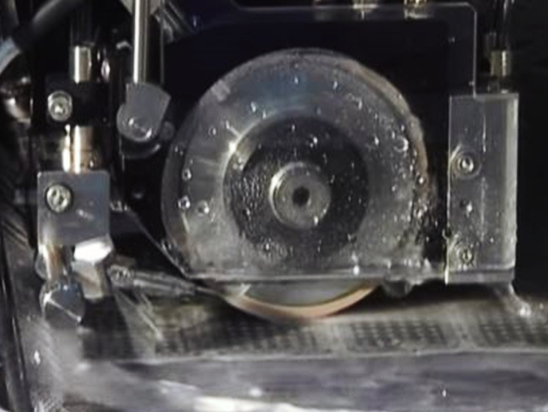
Dicing blade cutting mechanism
Impact
When dicing hard and brittle materials such as silicon with diamond dicing blade, the blade relies on high-speed rotation to cause hard particles such as diamond to impact the processed object with high-frequency pulses, forming micro-cracks on the surface. After crushing, the cutting edge is used to take away the debris.
Scraping
When cutting ductile metal materials, the blade edge continuously scrapes the surface of the object, roughens the surface, scrapes it off, and removes debris.
The impact of hard particles and the scraping of the blade edge enable the material to be peeled off the surface of the object. At the same time, the blade edge can remove debris in time. The two work together to keep the material on the surface of the object being continuously peeled off to achieve the cutting effect.
When manufacturing hubless diamond dicing blade, the molding methods generally include electroforming, powder press sintering or powder press heating and solidification molding, while hub type diamond dicing blade generally use electroforming.
When using a soft knife, it must be positioned and fixed on a special cutterhead (or flange), and then installed on a special cutting machine. When using a hard knife, it can be installed directly on the special cutting machine without the need for a cutter head
resin bond diamond dicing blade
(1)Resin bond is composed of thermosetting resin as a binder and various fillers. The properties and dosage of its various components have a great impact on the physical properties, mechanical properties and blade cutting performance of the binder. Therefore, the material and performance of the workpiece must be selected to achieve good cutting results.
(2)Resin bond diamond dicing bladescan be used as a binder material for resin dicing knives of hard and brittle materials. Phenolic resin is widely used. In addition, there are polyimide resin, epoxy resin, polyurethane, etc.
(3)The resin bond itself has good elasticity and polishing effect. After being combined with diamond abrasives to form a resin blade, it still has good self-sharpening properties, is not easy to block, and requires less trimming. It is often used for cutting packaging substrates, ceramics, glass and other materials. However, the resin bond has poor grip on abrasives and poor heat resistance, resulting in greater blade wear under high-temperature cutting.
Resin-bonded diamond dicing blades have good elasticity and can maximize cutting quality. They are suitable for processing difficult-to-process materials represented by glass and crystalline materials and various packaging materials.
Application of resin diamond dicing blade:
Resin bonded diamond dicing blades can be used to cut quartz, glass, lithium niobate, crystals and other brittle and hard materials, IC packages (QFN, DFN), etc.
Metal bond diamond dicing blade
(1)Metal bond include bronze and electroformed hub type diamond dicing blade.
(2)Bronze bond are generally based on copper and tin. In order to change its properties, some other metal powders, such as silver, nickel, zinc, etc., can be added. The above metal powder and diamond powder are fully mixed and evenly mixed, then placed in a mold to be pressed and sintered to form a soft metal blade. The bonding agent and abrasive grains of this kind of blade have high bonding strength, good wear resistance and low wear, so they have a long service life and can maintain good shape, so they can withstand larger loads. However, the disadvantage is that it has poor self-sharpening properties, the surface is easily clogged, it generates a lot of heat, and it is also very difficult to trim. Mainly used for cutting glass, ceramics, semiconductors and other non-metallic materials.
(2)The impact of metal bond on the performance of blades is multifaceted. Simply adjusting the tin and copper content cannot meet the needs. A certain proportion of other metal powders must be added to adjust. Adding an appropriate amount of lead to copper-tin alloy can improve the wear resistance; Adding an appropriate amount of nickel can improve the mechanical strength and wear resistance; adding silver powder can improve the mechanical properties and electrical conductivity of the alloy, and can greatly improve the flexural strength of the alloy. In addition, in order to achieve good process performance during manufacturing, there are strict requirements on the mixing method, molding pressure, mold structure, firing temperature rise curve, etc.
(3)Electroplating bond with higher bonding strength. Generally, a single layer or multiple layers of abrasive grains are plated on a metal substrate by electroplating. This kind of bonded tool has a thin abrasive layer and a high density of abrasive particles, and the surface of the tool can be cut easily. Sharp, high cutting efficiency, good economic benefits, no trimming require.
Metal bond diamond dicing blades have strong diamond holding ability and high wear resistance, and are suitable for precision cutting and grooving of electronic components and optical components.
Application of metal diamond dicing blade:
Metal bond diamond dicing blades can be used to process optical devices, ceramics, ferrite, quartz, IC packaging (BGA), optical communications (Faraday), etc.
The function of the bond in diamond tools is to firmly stick the diamond abrasives together. Bonding agents of different hardnesses have a greater impact on the life of the blade.
(1)The hubless diamond dicing blade can accelerate the “self-sharpening” of diamond particles, keep the dicing blade in a relatively sharp state, and reduce the problems of front chipping, delamination and burrs of the cutting material. The hard bond can better hold the diamond particles, increase the wear resistance of the blade, and extend the life of the blade.
(2)The disadvantage of the hubless diamond dicing blade is the shortened blade life, and the disadvantage of the hard bond is the poor quality of the cut product.

